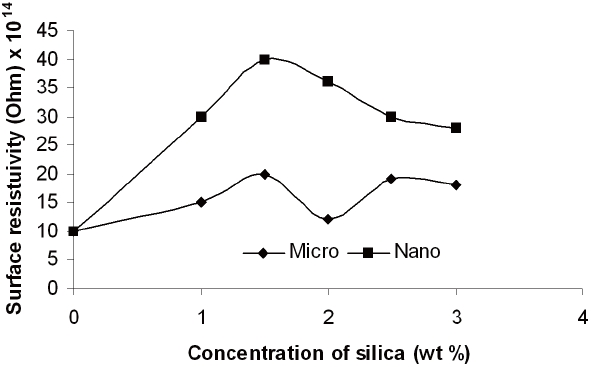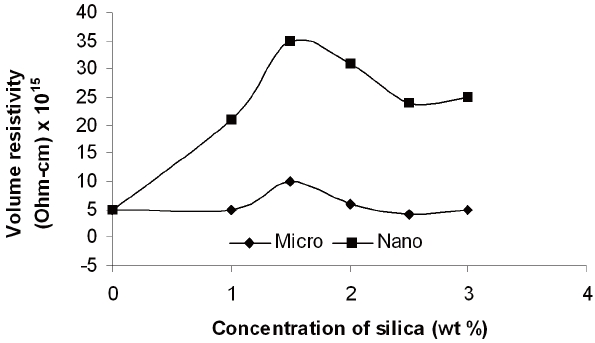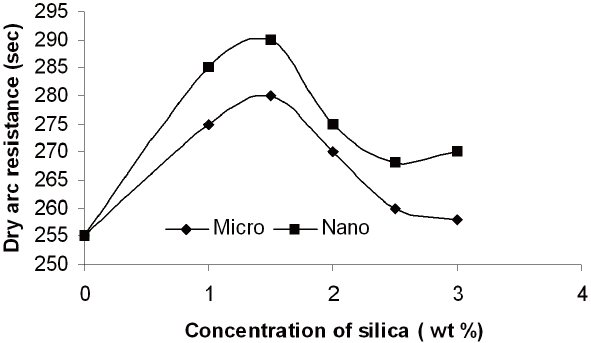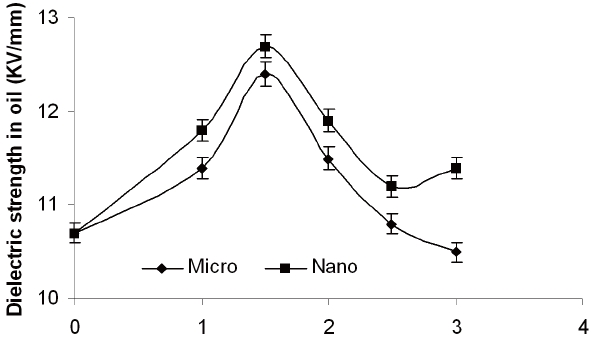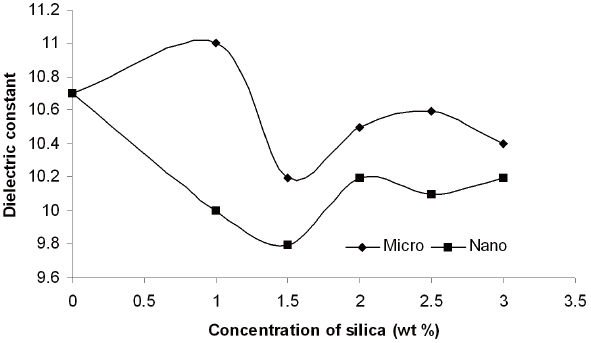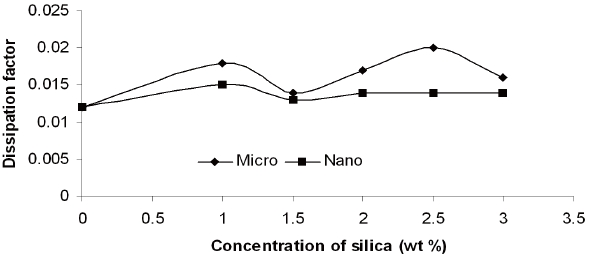



Nano inorganic fillers are used in polymeric matrix for improving the electrical, mechanical and physical properties [1,2]. It is reported by many researchers that the polymer nano-composites exhibits better electrical properties compared to other polymer micro composites [3]. It is documented that the 20 nm nano silica shows good dielectric properties than 100 nm silica composites [4]. The small nano particle have good hydrophobic property. This made the particle to form a bond easily with resin. Hence, the surface modification by a smaller particle is better than the higher sized nano particles.
In the last decade, most of the research have been conducted on epoxy-silica composites [5-7]. It was found out that an addition of a small amount of nano filler reduced tan delta and dielectric permittivity significantly compared to micro. One percentage dispersion of nano filler in polyester and polyesterimide system improves the mechanical, electrical and barrier properties [8]. Studies on polyacrylamide-silica composites recorded that the dielectric constant and the dielectric loss were smaller than the neat polymer [9,10]. But now a days, due to the lower price and easy availability of unsaturated polyester resin (UPR), it has an advantage over epoxy resin. Hence, a lot of research has been carried out on UPR composites.
An UPR-silica composite is one of the popularly used composite resins for electrical insulation application [11] like tape [12] varnish, UPR impregnated Kraft paper. The main application of UPR-silica composite is the insulation, of dry type transformer.These types of transformers are basically made of silica-UPR composites. Addition of nano material improves its partial discharge, dielectric strength and surface degradation properties. These composites are used in the manufacturing of the body and the insulation for transformers with various voltage ranges. Comparative studies of the electrical properties of silica nano and micro-UPR composites has been evaluated and reported in this paper.
The UPR used in the preparation of UPR-silica composites was obtained from M/s Naphtha Resins, Bangalore, India and it was used as such. The resin was pre-accelerated with 0.2% of cobalt naphthanate (6% Co content) and it had a solid content of 55%. Styrene was used as the reactive diluent. The acid value of the composition was 14 mg KOH/g resin. It had a viscosity of 330 mPas (@ 25℃ and 50 rpm). The initiator used for the cure of the unsaturated polyester resin was methyl ethyl ketone peroxide (MEKP). This was obtained from M/s Naptha Resins and was used as such. The nano silica used for the study was procured from Evonik Industries. India sold it under the trade name of Aerosil 300. The particle size of nano silica was 7 nm and it had a specific surface area of 300 m2/g. The particle size of the micro silica was 10 microns. It was used without any modifications and purchased from Evonik Industries, India.
The UPR-silica nano-composites were prepared by adding varying (0 to 2.5 phr by weight) amount of nano or micro-particle to the unsaturated polyester resin under mechanical agitation. The nano-particles were added in parts per hundred basis (phr) i.e. 1 phr indicates that 1 gm of the nano-particle was added per 100 g of resin. The mixture was then, subjected to ultrasonication coupled with mechanical agitation, using an rpm of 1,500 ± 50. This was done in a temperature controlled bath which was maintained at 25℃ for a period of 8 hours. Following the dispersion of the nano-materials in the polymer matrix the dispersion was degassed. The required amount of initiator was then, added and stirred. The composition was then poured into Teflon and metal moulds. They were allowed to cure at room temperature i.e. 25 ± 1℃ for 12 hours. This was followed by post-curing at 80 ± 1℃ for four hours. The composites were then, allowed to stabilize for 7 days at 25 ± 1℃ and it had 50% relative humidity before any testing was carried out.
2.3.1 Surface and volume resistivity
The surface and volume resistivity of UPR-silica composites were measured by using an electrometer model 6517 Keithley instrument. This was done according to ASTM D 257-2007. The samples used for evaluation of surface and volume resistivity had dimensions of 100 × 100 × 3 mm. The resistivity was measured at applied voltage 500 V DC and electrification time is 60 seconds
2.3.2 Dry arc resistance measurement
Dry arc resistance measurement of UPR-Silica composites was conducted using arc resistance IEC model 2 according to ASTM D 495-1999. The samples used for the evaluation of arc resistance had dimensions of 100 × 100 × 3 mm. The sample was exposed in an arc which was under a high current and low voltage condition. The sample was placed under the electrodes which were spaced at 6.35 mm. An arc is generated between these electrodes. The test consisted of seven cycles.
2.3.3 Dielectric strength
The dielectric strength of UPR-Silica composites were carried out according to ASTM D 149-2009. The samples used for the
determination of dielectric strength had dimensions of 150 ×150 × 3 mm. The electrodes were made up of brass alloys which were in the form of cylindrical shape. The measurements of the composites were done with an electrode surrounded by air at 25℃ and 30% RH. During the measurement high voltage was applied to the electrodes. It slowly increased until the dielectric broke down and a sudden increase of current occured. The effect of breakdown on the dielectric was visually observed after the sample was removed from an opening that was created by a sudden rush of current. The dielectric strength is calculated as the quotient of the measured breakdown voltage and the thickness of the sample dielectric:
2.3.4 Dielectric constant and dissipation factor
The dielectric constant and dissipation factor of UPR-Silica composites were measured using LCR meter HP 16451 B according to ASTM D 150-1998.
3.1 Surface and volume resistivity
The surface and volume resistivity of nano/micro-silica UPR composites were measured according to the method described above. They are presented in Figs. 1 & 2. It is clear from Figs. 1 & 2 that the surface & the volume resistivity of nano silica-UPR composites are better than silica UPR-micro-composites. The value of surface & volume resistivity was found to be higher at loading
of 1.5 phr nano silica particles. This was due to the better dispersion of silica nano particle [13].
The trends in volume and surface resistivity were observed due to the differences in the surface area of the nano and micro composites. With the same particle loading, nano particles had a higher interfacial area than the micro particles. This interfacial area provides a significant volume fraction of polymer surrounding the particles which improved properties from the bulk polymer [14].
3.2 Dry arc resistance measurement
The dry arc resistance measurement of the insulating material provides an assessment on the ability of insulation to withstand an electrical arc environment. The unit of arc resistance is the number of seconds that a material can resist the formation of a surface conducting path when subjected to an intermittent arc of low voltage and high current characteristic. This flashover or arcing phenomena occurs in all the different kinds of polymeric insulators which are used for outdoor applications in electrical devices. The formation of a conductive layer takes place on the surface of these out door polymeric materials due to the coating of dust or moisture during service. Hence, a permanent carbonized conducting path will form in the presence of an applied voltage due to the sparking on the conductive surface. This, causes the permanent failure of the polymeric insulating material. The arc resistance was measured using the above described method and is presented in Fig. 3.
It is clear from Fig. 3 that by the addition of a nano particle, the arc resistance increases compared to a micro silica particle in the UPR resin. The arc resistance was observed to be higher at composites made by the addition of 1.5 phr nano silica is due to
the good dispersion of the nano particle in the resin system and higher surface interaction in polymer and nanoparticles.
The dielectric strength is a measure of the electrical strength of the insulating material. Dielectric strength is defined as the maximum voltage required for causing a dielectric breakdown. It is expressed as kilovolt per unit thickness. The values of the dielectric strength of silica-UPR composites were measured as described above in section 2. It is depicted in Fig. 4. It is clear from the data shown in Fig. 4 that the value of the dielectric strength is slightly higher in nano silica-UPR composites when compared to micro silica based composites. It may be due to interfacial bonding between the UPR and the silica particles [15].
3.4 Dielectric constant and dissipation factor
The dielectric constant of silica-UPR composites were measured as described in the above testing section and is reported in Fig. 5. It is clear from Fig. 5 that the value of the dielectric constant is slightly lower in the nano silica-UPR composite. This is due to the successful interaction between the polymer and the surface of the silica particles [16]. The values of the dielectric constant keep decreasing till a loading 1.5 phr silica in UPR resin. After this, the values of the dielectric constant are almost the same. This may be due to the agglomeration of the silica particles in the UPR resin.
The dissipation factor is the ratio of a power loss in a dielectric material to the total power transmitted through the dielectric. This measure is the tangent of the loss angle:
Where:
Cp = equivalent parallel capacity
Rp = equivalent parallel resistance
δ = loss angle
The dissipation factor of silica-UPR composites has been evaluated using the above described method and is listed in Fig. 6.
It is clear from Fig. 6 that the addition of the nano silica in the UPR resin the dissipation factor decreases up to the nano silica loading of 1.5 percentages and then, it becomes constant. It may be due to the reduction of the internal discharge by the interfacial region of the polymer matrix and the filler at filler concentration more than 1.5 percentages.
The silica-UPR composites were prepared using the nano and micro silica particles. The electrical properties of pure UPR resin and its composites were evaluated. The investigation revealed that the nano silica-UPR composites exhibited better surface,volume resistivity, dry arc resistivity, dielectric strength, dielectric constant and dissipation factor when compared to the micro composites and neat resin. This was due to the surface and interface modification of the polymeric matrix by the nano material. Nano silica composites have larger inter-surface area than micro composites or pure resin due to the formation of one additional nano phase. Therefore it should show higher improved surface, volume and arc resistivity, dry arc resistance and tan delta. It is observed that the higher the dispersion of silica in the UPR resin better is the electrical property of silica-UPR composites.
